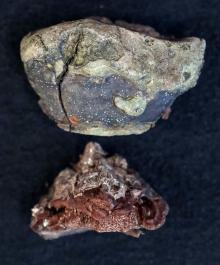Cause Two types of wood decay occur in living trees: white rots and brown rots. The more common fungal white rots in hemlock are caused by Ganoderma applanatus (white mottled rot), Ganoderma oregonense (spongy white rot), Phellinus nigrolimitatus (white pocket rot), and Porodaedalea pini (red ring rot). White rots cause all major structural components of the cell wall-cellulose, hemicellulose, and lignin-to degrade. The strength of white rotted wood decreases only in advanced stages of decay.
The more common fungal brown rots in hemlock are caused by Antrodia serialis (brown cubical pocket rot), Echinodontium tinctorium (brown stringy rot), Fomitopsis officinalis (brown trunk rot), Fomitopsis pinicola (brown crumbly rot), Laetiporus sulphureus (brown cubical rot), and Phaeolus schweinitzii (red brown butt rot, sometimes called the cow pie fungus). Brown rots cause most of the cell wall polysaccharides to degrade, but the lignin component is unchanged or slightly modified. The strength of brown rotted wood is significantly reduced or lost entirely shortly after decay begins. These rots usually are in exposed wood and can cause extensive damage, resulting in structural failure.
Injuries from pruning cuts, sunburn, or storm damage can expose susceptible wood. Large wounds, and stubs. and horizontal cuts are often entry sites for decay fungi. Wood decay generally is observed in older trees after extensive fungal colonization. Decay fungi frequently function as secondary invaders following a succession of microorganisms, including bacteria, yeasts, and other fungi. Decay in a single tree may be caused by more than one fungal species. Live trees are able to limit wood decay by walling off and compartmentalizing decay fungi but this can vary between different species and individuals. The CODIT model/principle (compartmentalization of decay in trees) is used by certified arborists to manage landscape trees with decay.
Some root rots, such as those caused by Armillaria sp., or Heterobasidion sp., or Perenniporia subacida can also extend up into the trunk and cause wood decay.
Symptoms White rots cause moist, soft, or spongy wood that is a lighter color than sound wood. For Ganoderma oregonense (spongy white rot), the rot is a soft, spongy, white rot containing numerous black spots scattered throughout. The annual conks measure up to 2-feet across and are usually shelf-like. The reddish-black to black upper surface is lacquer-like, while the lower, pore-bearing surface is whitish to cream colored.
Brown rots of wood are brown, dry, and crumbly, with longitudinal and transverse cracks. These rots usually are in exposed wood and can cause extensive damage, resulting in structural failure. For Laetiporus sulphureus, the wood is initially yellowish to reddish brown. As the color deepens, the wood becomes softer. Eventually the wood becomes a brown crumbly mass, which on drying cracks into cubes of varying sizes. The cracks are filled with mycelial felts of the fungus. The fruiting bodies (conks) develop in large, over-lapping clusters, often containing 20 to 50 or more individual conks. The conks are shelf-like and may possess an indistinct stalk or be completely stalkless. When fresh, the conks are fleshy and the upper surface is bright orange-red, the pore-bearing, under surface being sulfur yellow. As the conks weather, they bleach to a dirty white and harden, becoming brittle and finally chalky in texture.
Brown stringy rot - Echinodontium tinctorium - the decay first appears as a slight golden-tan discoloration then conspicuous rust-red streaks appear followed by a softening of the wood and a separating of the annual rings. Finally, the wood is reddish-brown to brown, fibrous, and stringy. As a result of complete disintegration of the decayed wood, the trunk becomes hollow and the tree is subject to wind throw. The perennial fruiting bodies (conks) are hard, woody, and hoof shaped. They are usually located at dead branch stubs. They may range up to a foot in diameter. The top is rough and cracked and dull black in color. The lower surface is gray white, and covered with hard, coarse, thickly set spines of uniform length. When broken open, the interior of the conk is a bright brick-red color. The presence of a single conk anywhere on the trunk of a tree indicates extensive decay.
Each of these wood decays leads to limb breakage and/or uprooted trees during wind or ice storms. Many trees have decreased vigor and dieback.
Cultural control
- Help prevent wood decay by using cultural practices that promote tree growth and vigor while minimizing injuries that expose wood. For example, mowing equipment should not injure the roots, crown, or lower trunk.
- Make pruning cuts adjacent to, but not into, the supporting branch, and prune when branches are small to enhance callus formation and wound healing.
- Irrigation water, especially from sprinklers, should not wet the trunks.
- Inspect trees for decay and/or conks to assess tree stability.
- Remove affected trees to avoid damage to surrounding property or spread to other trees.
Reference Shaw, C.G., and Harris, M.R. 1960. Important diseases and decays of trees native to Washington. Ag Extension Service, WSU. Extension Bulletin 540.

